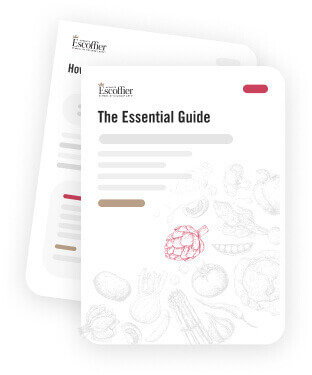Listen to This Article:
Of all the foods and culinary styles around the world, arguably nothing unites the masses more than cheese. People seem to almost universally love it, so much so that we may wonder what’s wrong if they don’t.
“The real question,” comedian Jim Gaffigan once tweeted, “is should we trust people who don’t like cheese?”
Kids grow up with grilled cheese sandwiches and mac and cheese, and adults pair it with wine or use it for a grown-up mac and cheese with a fancy name like fettuccine alfredo. It’s so popular that cheese consumption in the U.S. reached 42 pounds per person in 2022.
We may love it, but how much do we really know about this beloved food? If you’re ready to dive into some cheese history and a list of cheeses to know, keep reading.
A Happy Accident: The History of Cheese
Cheesemaking has been around for thousands of years, and while no one really knows how cheese was invented, the leading theory is a fun one. Legend has it that an Arabian merchant put milk into a pouch made from a sheep’s stomach, and that chemistry went to work—the rennet in the pouch and the heat of the desert broke the milk down into curds and whey. The merchant found himself with a drink and a snack when he opened the pouch.
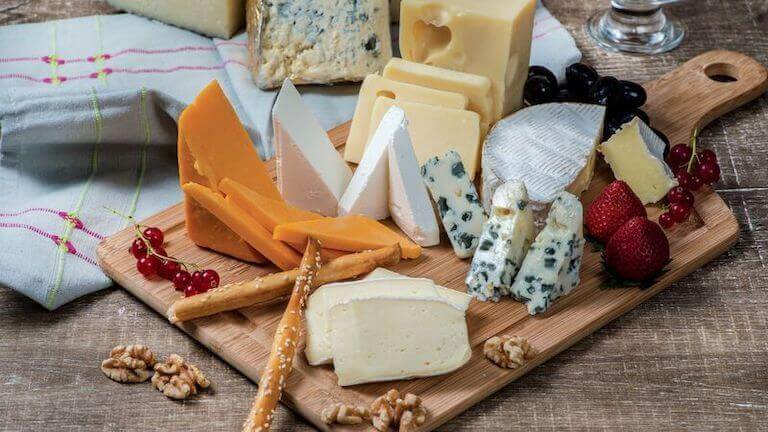
Cheese offers a wide range of flavors and an endless number of interesting pairings.
Homer’s Odyssey, from the 8th century BCE, mentions cheese. Evidence of cheesemaking dating back to 5500 BCE has been found in Kuyavia, Poland, with the discovery of strainers coated with milk-fat molecules.
And cheese discoveries are still occurring. In 2024, researchers determined that a substance found on mummies in a cemetery in China was the world’s oldest cheese, a kefir cheese from more than 3,500 years ago. The Bronze Age discovery was “among the few dairy remains preserved more than 3,000 years.”
That’s alotta Cheddar: The Evolution of Cheese Production
The Roman Empire was into cheesemaking, which then spread to England. After the fall of Rome, monks in medieval monasteries continued to hone the craft during the Middle Ages, and we can thank the Italian monks for creating gorgonzola and roquefort varieties.
Cheese was aboard the Mayflower when it landed in America, and early settlers continued to make it, usually on their own farms. In 1851, Jesse Williams built the first commercial cheese factory in the United States in Rome, New York.
Williams advocated for farmers to work together to not only improve profits, but to establish standards of quality and uniformity in cheese; the factory produced 100,000 pounds of cheese its first year, and within 15 years, 500 more factories had sprung up around the state. In recognition of Williams’ contributions, Oneida County erected a historical marker in his honor in Rome in 1970.
Today, of course, cheesemaking runs the gamut from large factories to artisanal producers and home cooks. According to the Food and Agriculture Organization of the United Nations, the European Union and the United States account for 76 percent of the world’s cheese production (47% from the EU and 29% from the U.S.).
How much cheese is that? In the U.S., that comes out to 6.45 million metric tons of cheese produced in 2023-2024.
Milk’s Leap Toward Immortality: How Cheese is Made
In science terms, cheese is coagulated casein protein, which admittedly doesn’t sound appetizing. Put more plainly, it’s about creating curds from milk, then treating and/or aging the curds to produce different types of cheese.
Cheese is usually made from four ingredients: milk, culture, salt, and rennet … but mostly milk. It takes about 10 pounds of whole milk to make one pound of cheese.
“Cheese,” American author John Updike wrote in Rabbit, Run, “is milk’s leap toward immortality.”
A cheese’s flavor is determined by the type of milk used (cow, sheep, goat, buffalo), how the cheese is made, and the aging process.
What is Terroir?
Cheese’s flavor, like wine, is influenced as much by where it’s made as how it’s made. Terroir refers to “the geographical conditions of a place that affect the taste of what is grown.”
Factors include the soil, elevation, climate, what the cows or sheep graze on, the animals’ breed, all of which affect the cheese’s flavor.
Some cheeses can only bear certain names if they come from a specific breed and a specific location. Manchego, for example, can only come from the La Mancha region of Spain and must be made with the milk of Manchega sheep. Parmigiano-reggiano can only come from the provinces of Parma, Bologna, Mantua, Modena, or Emilia Romagna in Italy.
6 Steps From Milk to Cheese
The aging process, or cheese ripening, “is initiated by the addition of a starter culture and coagulant to milk,” explains ScienceDirect. The resulting biochemical reactions influence the development of flavor, aroma, and texture.
There are typically six steps involved in cheese making:
- Milk is pasteurized, or mildly heated to kill bacteria.
- Fermenting, during which a starter culture is added to the milk; this good bacteria helps increase acidity levels and break the milk down. Fermentation helps dictate the moisture and mineral content of your curds, and has a big role in determining the taste, texture and characteristics of your finished cheese
- Rennet, or enzymes that coagulate milk, are added to thicken the milk.
- The milk separates into curds (solid clumps) and whey (liquid).
- The whey is drained and the curds are cut into smaller pieces and cooked again; salt is added to dry and preserve the cheese. At this stage, you have unripened cheese like cottage cheese, mozzarella, or cream cheese.
- Cheeses are put into molds and left to age/ripen, typically from a couple of months to a year.
How Do You Make Vegan Cheese?
If cheese is almost all milk, how is a non-dairy version created? One of the most popular options is to use cashews and blend them into a paste before putting them through a similar fermentation process as cheese.
Other cheeses are created with a plant-based milk before cultures and thickeners are added. In either case, the cheese undergoes an aging process.
The trick in vegan cheese is in finding a way to recreate the melting and stretchiness you get with a dairy version. Cow’s milk has a protein called casein that liquifies when heated, and as yet, a substitute has not been found for vegan offerings. However, vegan cheeses have come a long way and many brands have found workarounds that provide a satisfying gooeyness and flavor, plus some vegan cheeses that have their own unique flavor profiles.
Types of Cheese: Fresh, Aged, Soft, Hard
Broadly speaking, cheese is categorized by firmness; the moisture in a cheese helps determine its texture, flavor, and the type of rind it develops. Higher moisture means a softer cheese, while lower moisture means a hard cheese.
With this in mind, there are six basic types of cheese: fresh or unripened; soft or soft-ripened; semi-soft; semi-firm; hard; and blue. There’s some crossover between categories and, as with wine, variations in flavor depending on region and country.
Also similar to wine, cheese has various flavor profiles and “notes.” These are affected by the type of milk, aging process, bacteria cultures, and even the animal’s diet.
Some of the most common terms to describe cheese include creamy, buttery, nutty, tangy, sharp, earthy, fruity, pungent, and bloomy. Some people splice it even further into flavors that include grassy, soapy, astringent, goaty, musty, umami, and dozens more.
There are thousands of types of cheese around the world. This list is by no means exhaustive, but here are 30 cheeses you should know:
Fresh/Unripened
Fresh or unripened cheese is young cheese (less than 30 days) with a high moisture content. It usually hasn’t developed a rind, is bright white inside and out, and is often creamy though you might also get a crumbly one like feta, which has been pickled in salt.
It might be covered in herbs or rolled in ash, which is a food-grade ash made from salt and oak charcoal or vegetable ash that is sometimes called activated charcoal. The ash is sterile, odorless, and tasteless. It helps prevent a rind from developing and neutralizes the acidity in the curds while also affecting the flavor of the cheese.
Examples:
Mozzarella—Often described as having a “clean” taste, mozzarella is fresh, milky, mild, and elastic or stringy and is often eaten the same day it’s made. Though traditionally made with buffalo milk, in the U.S. it’s usually made with cow’s milk. You’ll find it on pizza and in caprese salads; it pairs well with red wine.
Ricotta—Creamy and thick, mild and slightly sweet, often described as “spongy.” Ricotta is made with a variety of types of milk (cow, sheep, goat) and is used for sweet fillings in dishes like cannoli or savory dishes like stuffed shells and lasagna.
Cottage cheese—Mild, creamy, and a little salty, cottage cheese is distinctively lumpy and eaten with a spoon. It’s made from cow’s milk. Slightly acidic, it pairs well with fruit like berries but can also be mixed with savory flavors and turned into a dip or used in baking and casseroles.
Mascarpone—Mascarpone comes from northern Italy and is sweet and buttery. Made from heavy cream, it’s often associated with desserts like tiramisu, but can also be used in savory dishes. Spreadable and creamy.
Goat Cheese—Also known as chevre, goat cheese is earthy, tangy, and spreadable, and pairs well with both sweet and savory.
Burrata—Creamy, mild buttery, and milky, burrata has a soft outer mozzarella shell and a creamy, mild center. Works well with pasta and salad.
Halloumi—Halloumi is fresh, minty, and salty. It’s popular in grilling and frying, and is often grilled and drizzled with honey, then served with fruit.
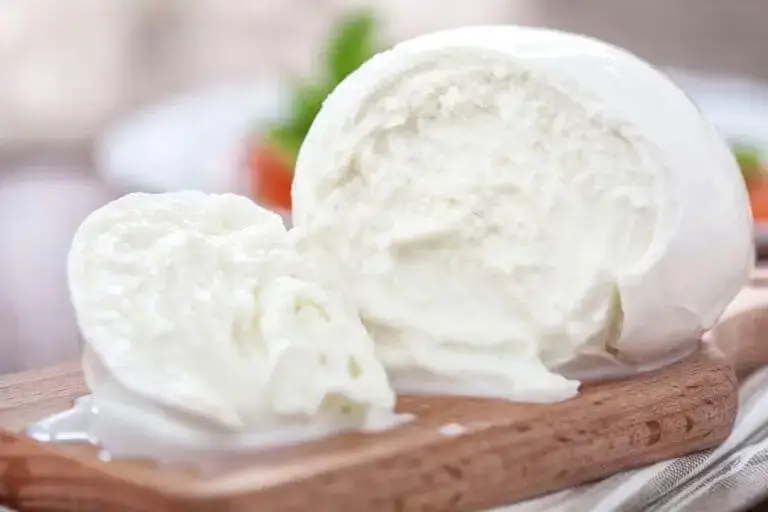
Unripened cheeses don’t have rinds and are white inside and out.
Soft/Soft-Ripened
Soft or soft-ripened cheese has a high moisture and fat content and has been ripened one to two weeks. It usually has a fine, white rind.
Examples:
Brie—Smooth and creamy, with a buttery flavor, brie originated in France and is made with cow’s or goat’s milk. It has a bloomy outer rind and pairs well with sour or tart flavors like green apples, raspberries and cherries as well as honey and nuts. Melts beautifully.
Camembert—Stronger than brie, camembert comes from France, is made with cow’s milk, and is earthy and grassy. It has a white rind and a runny interior and pairs well with sweet fruits like strawberries; it can also be blended with herbs.
Humboldt Fog—Made in California from goat’s milk, humboldt fog is creamy and floral, and slightly crumbly. It pairs well with pears, dark chocolate, and nuts.
Feta—Tangy, salty, and crumbly, feta has been formed into a block and pickled in a brine. It usually comes from Greece and is made from sheep’s milk or a combination of sheep’s and goat’s milk. Pairs well with vegetables and is popular in salads.
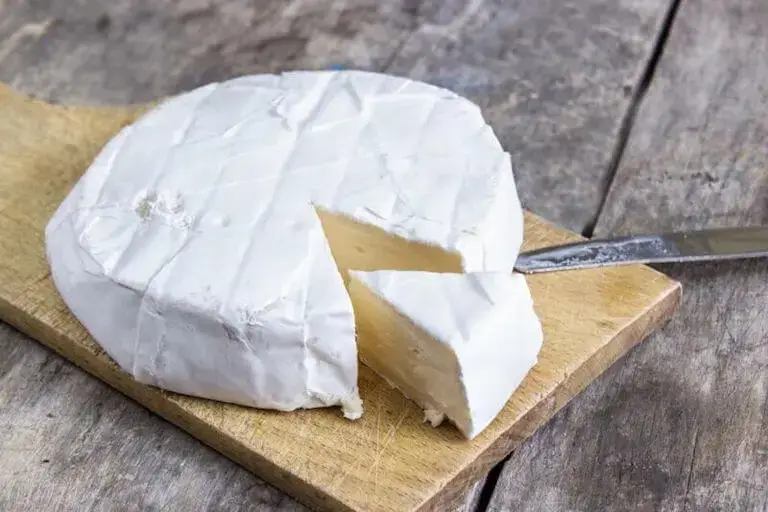
Soft cheeses are fresh and usually boast a mild, clean flavor.
Semi-Soft
With semi-soft cheeses, the curd has been lightly pressed into molds, and the type of rinds vary from thinner to thicker. The rinds reflect the cheese’s flavor—a thinner rind tends to surround a milder cheese while a thicker rind tends to be a more pungent and earthy cheese. Some stinky cheeses fall in the semi-soft category.
Examples:
Muenster/Munster—Mild and creamy, with an orange rind, munster becomes more tangy as it ages. It is sometimes described as a cross between mozzarella and mild cheddar.
Taleggio—Taleggio is fruity and tangy with a strong aroma but a mild, mellow flavor; it melts well.
Havarti—Havarti is sharp and somewhat sweet, creamy and elastic, and made with cow’s milk. It melts well and is a good pairing for walnuts, figs, and raisins.
Provolone—Provolone is smooth and firm, sharp yet buttery. It is made from cow’s milk and is popular in sandwiches and with savory dishes, pairing well with a variety of vegetables like roasted red peppers and olives as well as fruits like figs or grapes.
Limburger—Limburger is pungent and somewhat spicy. Made with cow’s milk, its texture ranges from crumbly to soft depending on how long it aged. It has an orange-pink rind because of salt brine washings during the aging process.
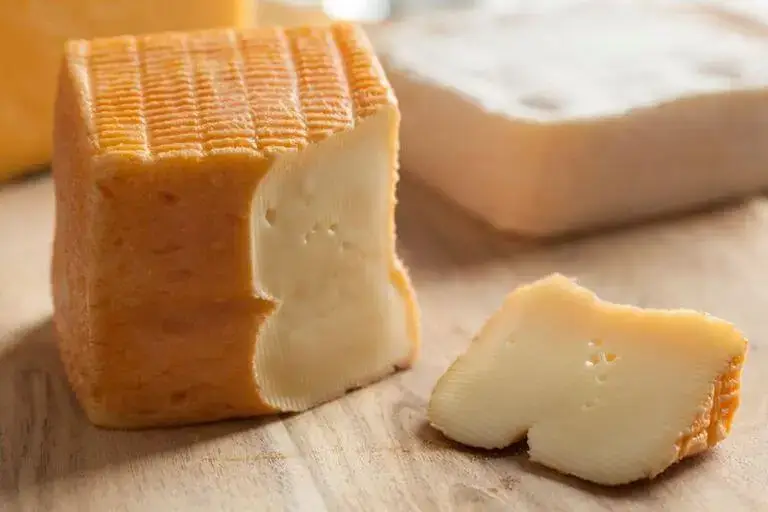
Semi-soft cheeses sometimes have orange rinds and pungent flavors and aromas.
Semi-Firm or Semi-Hard
Semi-firm or semi-hard cheeses have aged longer and exist in an in-between state, not hard enough for grating and not soft enough to spread. They are meant for slicing and shredding.
Examples:
Cheddar—This cheese originated in the village of Cheddar in England. Its flavors are sharp, umami, bold, and its texture is often crumbly. It pairs well with cherries and apples, hearty bread, and is popular in grilled cheese because it melts well and adds robust flavor; it also goes famously well with apple pie.
Gouda—Gouda’s flavor is often described as having notes of caramel or toffee. It pairs well with foods that have a bite, like arugula, and also goes well with olives and dates. Made from cow’s milk, gouda melts well and is often used in fondue, tarts, and casseroles. It sometimes has flavor added to produce a smoked gouda. The rind is treated with saffron-infused vinegar and coated in wax.
Gruyère—Nutty, savory, earthy, and salty with a grainy texture, gruyère is excellent in a charcuterie board alongside prosciutto and salami. It also goes well with figs and pears and works well in soups and in baking. It has been aged for at least six months.
Edam—Mild, nutty, and salty, edam is made with cow’s or goat’s milk and is also packed in wax like gouda. It goes well with fruits and bread.
Emmental—Buttery, tangy, and nutty, emmental is a Swiss cheese injected with a bacteria that releases carbon dioxide that results in “holes.” It is popular on sandwiches and in fondue and has aged for two to 18 months.
Monterey Jack—A popular snacking cheese that also melts well, monterey jack is mild, buttery, and made with cow’s milk. It originated in California.
Fontina—Fontina is nutty and mild, similar to gouda and edam.
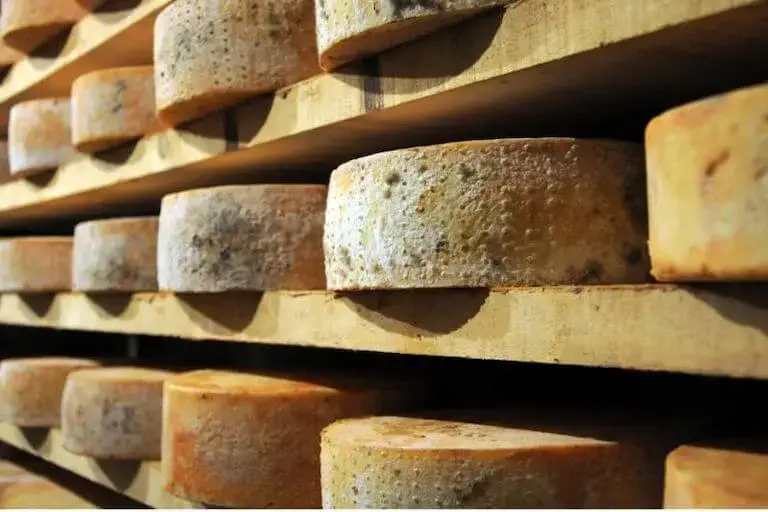
Semi-firm cheeses usually have a distinctive rind and their flavors range from mild to sharp.
Hard Cheese
Hard cheese has a low moisture content. The curd has been pressed to remove the whey, and the cheese has become compacted. Hard cheeses take longer to age and usually have a stronger flavor, a dry texture, and often a crunchy feel. They are best for grating and slicing thin.
Examples:
Manchego—Creamy and tangy with a somewhat crystallized texture, manchego is made with sheep’s milk and comes from the La Mancha region of Spain. It goes well with roasted red peppers, sun-dried tomatoes, and olives, and is good in salads.
Parmigiano-Reggiano—Parmigiano-reggiano is salty and dry, nutty, and crumbly. It is made from cow’s milk and comes from the provinces of Parma, Bologna, Mantua, Modena, or Emilia Romagna in Italy. If made elsewhere, it’s referred to as parmesan. This cheese is excellent for grating and is often used on pasta and salads; it pairs nicely with balsamic vinegar.
Pecorino romano—Peppery and pungent, made with sheep’s milk, pecorino romano goes well with cured meats, sausages, and heart vegetables as well as balsamic vinegar. It also contrasts well with sweet flavors like jams and honey.
Asiago—Sharp and piquant, similar to parmesan, asiago is usually grated over pasta and other Italian dishes and salads.
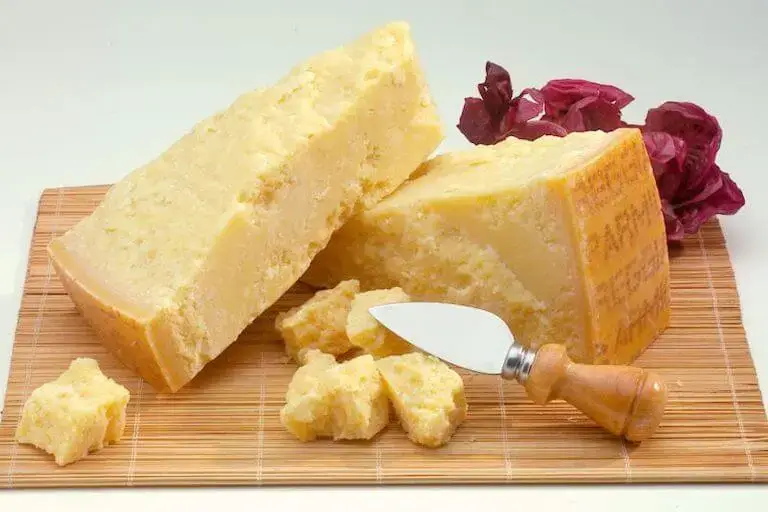
Hard cheeses are good for slicing and grating, and a little goes a long way because of their strong flavors.
Blue
Blue cheese combines the creamy elements of soft cheese with the pungent and strong flavors of hard cheeses. Mold is injected during the cheesemaking process, usually a Penicillium culture that helps soften the curd and influences flavor. The cheese is also “needled” to create more spaces for mold to grow.
Examples:
Roquefort—Crumbly and moist, tangy and salty, roquefort is made with sheep’s milk and comes from southern France; it goes well with nuts and fruits.
Gorgonzola—Gorgonzola is soft and crumbly, salty, and earthy. Its flavors range from creamy to pungent depending on how long it’s been aged. Made with cow’s milk, gorgonzola goes well with fruits and jams and has distinctive blue veins.
Stilton—Made with cow’s milk and aged for at least nine weeks, stilton is crumbly and soft, salty, nutty, and sweet.
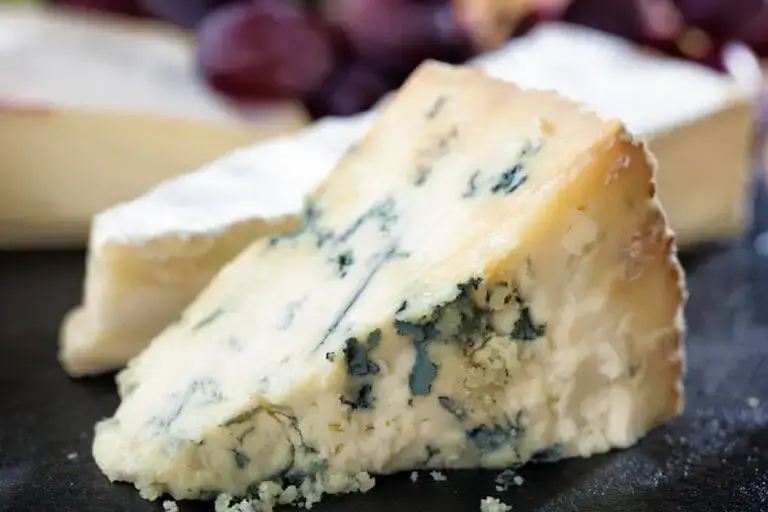
Blue cheeses are usually pungent and display prominent blue veins.
Why Would We Eat Mold?
In a Jimmy Fallon skit that spun real online comments into a song, people who said blue cheese was their favorite salad dressing were hounded by a woman who kept replying with one line: “Blue cheese has mold in it.”
She wasn’t wrong. At the same time, her apparent concern was potentially misplaced. Although the same fungus used in blue cheese can result in spoilage to bread and silage, it doesn’t pose a health threat when used properly in cheese, and blue cheese is aged in its own cave, away from other types.
Penicillium roqueforti is injected into cheese to soften the curd, and the enzymes it produces also help produce a chemical reaction that turns milk fat into free fatty acids, which results in blue cheese’s unique flavors. It also creates the distinctive blue-green veins.
Can You Eat the Cheese Rind?
If you’ve ever unwrapped a wheel of cheese and wondered what to do with the rind, you’re not alone.
According to The Academy of Cheese, the question isn’t whether you can eat the rind, but whether you should. Unless the rind is coated in wax or cloth, it’s generally considered safe to eat. The Academy likens the rind to the crust that develops on bread; it might form naturally or a cheesemaker might brush or pat the cheese down, or wash the rinds with brine or oil.
“Most organic rinds are naturally edible and can, in most instances, actually enhance the cheese’s flavour,” according to the website.
The Academy of Cheese puts rinds into three categories:
- Bloomy—earthy, reminiscent of mushrooms and yeast
- Washed—with sticky and orange skins, they might look and smell ugly but have a nutty, beefy flavor
- Natural—rinds that form with little intervention from the cheesemaker and have a range of flavors
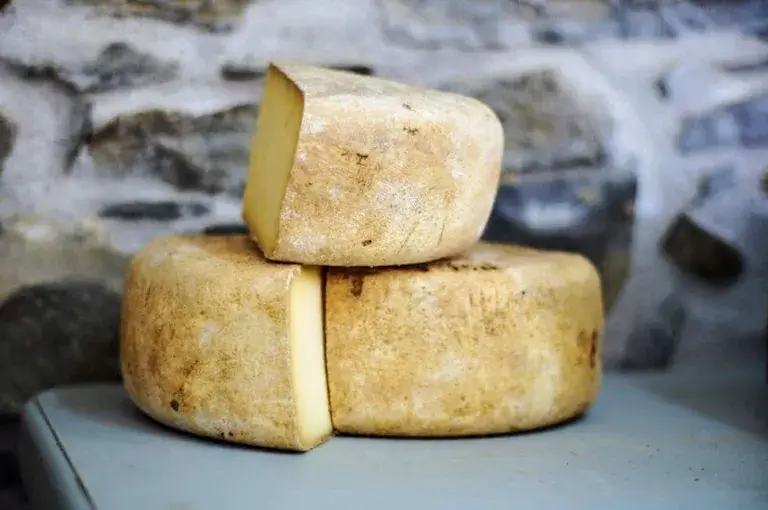
Though they might not at first appear so, most cheese rinds are edible and feature lots of flavor.
Explore Flavor Profiles and Pairings at Culinary School
Cheese is a great example of a food that starts with simple ingredients and can wind its way through innumerable possibilities. From mild to sharp, soft to hard, eaten alone or cooked in a decadent dish, cheese can be almost anything you want it to be.
If you enjoy exploring flavor profiles and creative uses for ingredients, culinary school can be a good place to help enhance your knowledge and get hands-on experience in a kitchen with feedback from skilled chef instructors.
Contact us to discover how our programs can help you elevate your skills and potentially lead to a culinary career where you can continue experimenting.
